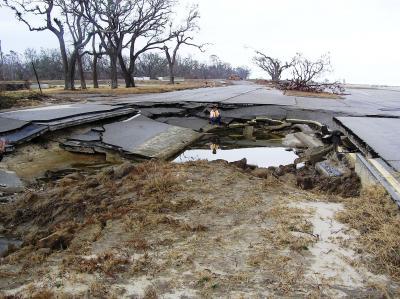Two of the world's worst natural disasters in recent years stemmed from different causes on opposite sides of the globe, but actually had much in common, according to researchers who are part of a large National Science Foundation-funded research initiative that has been studying both the Indian Ocean Tsunami of 2004 and the Hurricane Katrina of 2005. As a storm surge recedes, the sudden decrease in downward pressure on the saturated soil causes the sand to liquefy and to flow out like a heavy slurry. This can result in giant potholes like this 6 foot-deep one on the coastal highway. Credit: Princeton University School of Engineering and Applied Science
As a storm surge recedes, the sudden decrease in downward pressure on the saturated soil causes the sand to liquefy and to flow out like a heavy slurry. This can result in giant potholes like this 6 foot-deep one on the coastal highway. Credit: Princeton University School of Engineering and Applied Science
One of the research team's surprising conclusions: when it comes to the damage they wreak, hurricanes and tsunamis can bring surprisingly similar forces to bear.
"A lot of the hurricane damage along the Mississippi coastline came from storm surges -- not from high winds or levee flooding that occurred in the New Orleans area," said Yin Lu "Julie" Young, an assistant professor of civil and environmental engineering at Princeton University. "Storm surges result in very different mechanisms. When it comes to forces on a structure, what happens in a storm surge is very similar to what happens in a tsunami."
During a storm surge, structures that were built to withstand the downward force of gravity now must cope with a totally different force: the upward and lateral push of water. In addition, buildings have to withstand assaults from debris caught up in the surge.
"Eighteen-wheeler containers, freed floating barges, and boats can all become projectiles that will strike objects in their path," said Young. "Large debris may also become lodged between structural elements like columns and lead to complete collapse of the structures."
Young's collaborators are Ronald Riggs and Ian Robertson, professors at the University of Hawaii at Manoa, and Solomon Yim, a professor at Oregon State University. The team members will publish their work in an upcoming special edition of the Journal of Waterway, Port, Coastal and Ocean Engineering.
During their two field visits, the team took more than 2,000 photographs of the destruction to the Mississippi coast. An exhibition of photographs culled from that collection opens today during a reception at Princeton University's School of Engineering and Applied Science. The photographs will be on view through May 11.
One of Young's favorites is a photograph of a stack of delicate unchipped china that survived the storm completely unharmed. All that remains of the church where the china was used is a bent steel frame. "You have to appreciate the irony of nature," Young said. "Most of the time, the scenery is tragic, ironic, and beautiful all at the same time."
One of the group's interesting research findings from the Mississippi work has to do with a phenomenon better known for occurring in neither hurricanes nor tsunamis but, rather, earthquakes. That is something known as "liquefaction." As the storm surge recedes, the sudden decrease in downward pressure on the saturated soil causes the sand to liquefy and flow out like a heavy slurry. This can lead to the eventual collapse of buildings, highways, or bridge abutments, as well as gigantic potholes along coastal roads.
The team was award a NSF NEES-SG grant to study the effect of tsunamis on engineered structures. The final goal of the project is to develop design recommendations to enhance the safety of coastal infrastructures subject to tsunamis.
"If you consider the gravitation, wind, seismic and wave forces, as well as the surrounding soil composition, a building can be designed such that it should be available for immediate occupancy after a minor event, and be able to remain structurally intact to allow for safe evacuation during a Category 3 hurricane like Katrina," said Young.
Understanding how to build hurricane-resistant buildings is one thing; getting society to implement that knowledge is quite another, Young said. "Politics and human values come into play," she said. "People are resilient and have short memories and think that if another hurricane comes along they can just rebuild. I admire their strength but at the same time there is a certain stubbornness about not learning from past mistakes. People like to do what they did before because it's easier than fixing the root of the problem."
Last week, Young gave a presentation on her research at the Massachusetts Institute of Technology. She will also be giving presentations at the Oregon State University, California Institute of Technology, the University of Southern California, and the University of California at Berkeley. "We hope to present our findings widely so that engineers can learn from this and modify future design codes to minimize damage," she said.
Source: Lessons from Hurricane Katrina Storm Surge on Bridges and Buildings By Ian N. Robertson[1], H. Ronald Riggs[2], Solomon Yim[3] and Yin Lu Young[4]
[1] Professor, Dept. of Civil and Environmental Engineering, University of Hawaii at Manoa, Honolulu, Hawaii
[2] Professor and Chairman, Dept. of Civil and Environmental Engineering, University of Hawaii at Manoa, Honolulu, Hawaii
[3] Professor, Dept. of Civil, Construction and Environmental Engineering, Oregon State University, Corvallis, Oregon
[4] Assistant Professor, Dept. of Civil and Environmental Engineering, Princeton University, Princeton, New Jersey